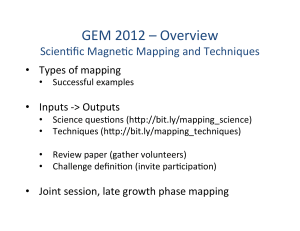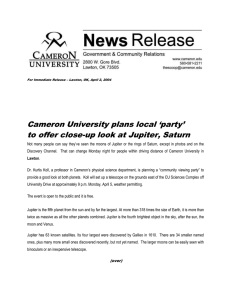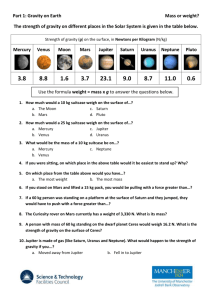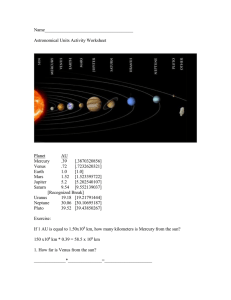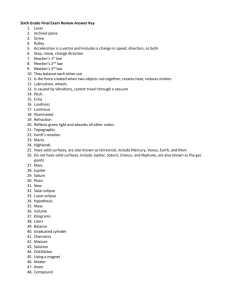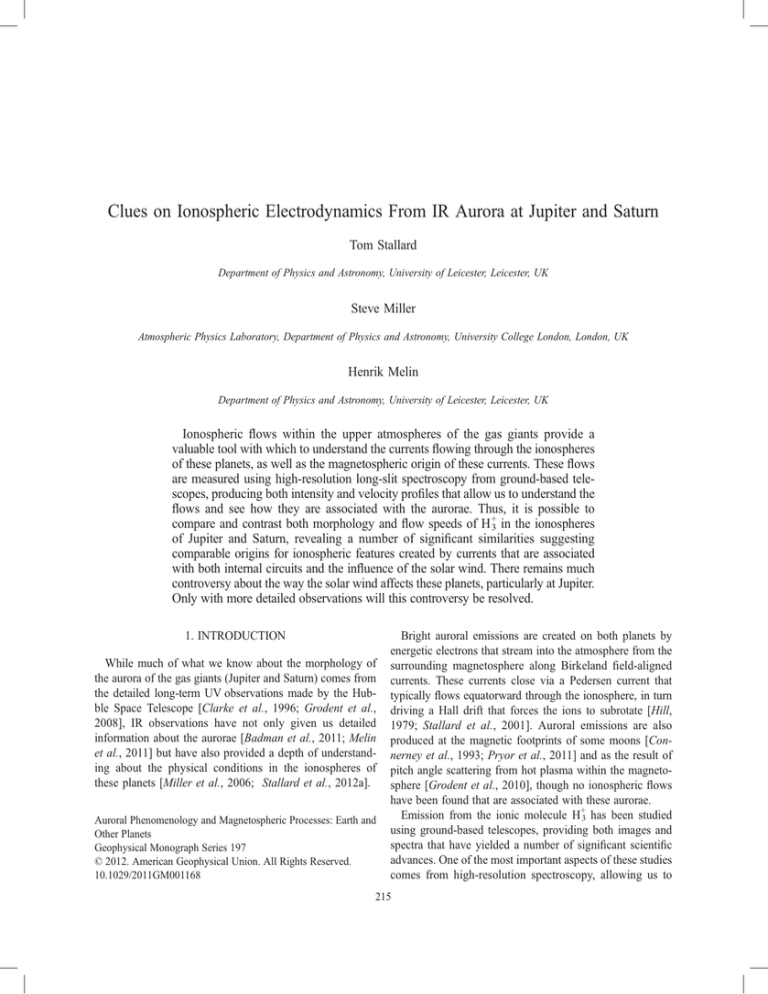
Clues on Ionospheric Electrodynamics From IR Aurora at Jupiter and Saturn
Tom Stallard
Department of Physics and Astronomy, University of Leicester, Leicester, UK
Steve Miller
Atmospheric Physics Laboratory, Department of Physics and Astronomy, University College London, London, UK
Henrik Melin
Department of Physics and Astronomy, University of Leicester, Leicester, UK
Ionospheric flows within the upper atmospheres of the gas giants provide a
valuable tool with which to understand the currents flowing through the ionospheres
of these planets, as well as the magnetospheric origin of these currents. These flows
are measured using high-resolution long-slit spectroscopy from ground-based telescopes, producing both intensity and velocity profiles that allow us to understand the
flows and see how they are associated with the aurorae. Thus, it is possible to
compare and contrast both morphology and flow speeds of H +3 in the ionospheres
of Jupiter and Saturn, revealing a number of significant similarities suggesting
comparable origins for ionospheric features created by currents that are associated
with both internal circuits and the influence of the solar wind. There remains much
controversy about the way the solar wind affects these planets, particularly at Jupiter.
Only with more detailed observations will this controversy be resolved.
1. INTRODUCTION
While much of what we know about the morphology of
the aurora of the gas giants (Jupiter and Saturn) comes from
the detailed long-term UV observations made by the Hubble Space Telescope [Clarke et al., 1996; Grodent et al.,
2008], IR observations have not only given us detailed
information about the aurorae [Badman et al., 2011; Melin
et al., 2011] but have also provided a depth of understanding about the physical conditions in the ionospheres of
these planets [Miller et al., 2006; Stallard et al., 2012a].
Auroral Phenomenology and Magnetospheric Processes: Earth and
Other Planets
Geophysical Monograph Series 197
© 2012. American Geophysical Union. All Rights Reserved.
10.1029/2011GM001168
Bright auroral emissions are created on both planets by
energetic electrons that stream into the atmosphere from the
surrounding magnetosphere along Birkeland field-aligned
currents. These currents close via a Pedersen current that
typically flows equatorward through the ionosphere, in turn
driving a Hall drift that forces the ions to subrotate [Hill,
1979; Stallard et al., 2001]. Auroral emissions are also
produced at the magnetic footprints of some moons [Connerney et al., 1993; Pryor et al., 2011] and as the result of
pitch angle scattering from hot plasma within the magnetosphere [Grodent et al., 2010], though no ionospheric flows
have been found that are associated with these aurorae.
Emission from the ionic molecule H+3 has been studied
using ground-based telescopes, providing both images and
spectra that have yielded a number of significant scientific
advances. One of the most important aspects of these studies
comes from high-resolution spectroscopy, allowing us to
215
216
IONOSPHERIC ELECTRODYNAMICS AT JUPITER AND SATURN
measure the line-of-sight velocity of H+3 in the ionosphere
and, from this, to understand the current systems flowing
through the upper atmospheres of these planets [Stallard
et al., 2001].
H +3 is formed through a fast chain reaction process beginning with the ionization of molecular hydrogen into H+2.
The H +2 ion is then rapidly converted to H+3 by a strongly
exothermic reaction [Yelle and Miller, 2004]. On both planets, the majority of ionization is in the auroral region by
precipitating energetic electrons, but also occurs, globally,
by solar extreme ultraviolet (EUV) radiation ionizing molecular hydrogen.
H +3 is, under most conditions, a highly reactive molecule,
and is quickly destroyed in the presence of any species other
than hydrogen or helium (since He has a lower proton affinity than H2). However, in the upper atmosphere of Jupiter
and Saturn, species concentrations are controlled by diffusion, such that they each settle out with their own scale
height. In a hydrogen-rich atmosphere, this means that heavier species settle out, and at higher altitudes, H+3 protonating
reactions cannot take place [Yelle and Miller, 2004]. As a
result, the lifetime of the H+3 molecule is directly controlled
by dissociative recombination, which occurs at a rate given
by McCall et al. [2005] as 2.6 10 13 m3 s 1. This means
that H +3 lifetimes are typically between a few and a few
thousand seconds, for electron densities between 1012 and
109 m 3, respectively. These lifetimes are a factor of 500 and
500,000 times longer than the typical radiation lifetime of a
rovibrationally excited H+3 molecule, for which Einstein Aif
coefficients range between ~10 and 100 s 1 [Neale et al.,
1996].
However, the IR auroral emission of H +3 is a thermal
emission, directly affected by the conditions within the upper
atmosphere [Miller et al., 1990]. Simultaneous observations
of the auroral region in both wavelengths have been made
from Earth for Jupiter [Clarke et al., 2004] and using in situ
images at Saturn [Melin et al., 2011]. While these show that
the general morphology of the H+3 and UV auroral emission
matches, there are still significant variations caused by the
ionospheric conditions, as well as altitudinal differences,
with H +3 brightness being enhanced with increasing altitude
at Jupiter due to increases in temperature [Lystrup et al.,
2008]; interestingly, it appears that H+3 emission appears to
be relatively weaker than the UV emission at higher altitudes
above Saturn [Stallard et al., 2012b].
Since H+3 has an approximate lifetime of 10 min in the
upper atmosphere of the gas giants, the molecule can interact
with the surrounding neutral atmosphere through collisions.
H +3 then takes on the thermal characteristics of the surrounding neutral atmosphere, with auroral brightness strongly
controlled by temperature, especially at Saturn. This interac-
tion also strongly affects ionospheric velocities, as a continual accelerating force moving ions back into corotation with
the planet. As such, the measurement of ion flows within the
ionosphere, moving against this background neutral atmosphere, provides a direct measure of the electric currents that
cross the ionosphere.
2. VELOCITY MEASUREMENTS
While, at first appearance, there are notable brightness and
morphological differences between the aurora of Jupiter and
Saturn, the flow speeds of H +3 in the ionospheres can be
directly compared and contrasted. In looking at the phenomenology of H +3 at each planet, a number of significant similarities have been shown to exist, so that apparently,
contrasting features can be shown to have similar origins.
Equally, there are also some features of intensity and velocity
that may be unique to each of these planets.
Using high-resolution long-slit spectroscopy, it is possible
to measure the H +3 velocity in the line of sight. The peak
intensity and position of a particular line of H+3 emission can
be calculated by fitting the line with a Gaussian in the
wavelength direction; by repeating this process across all the
spatial rows of the spectral slit, a profile of intensity and ion
wind velocity can be produced (for more details of this
process, including the instrumental corrections required, in
the case of Jupiter, see Stallard et al. [2001], and of Saturn,
see Stallard et al. [2007a]).
Figure 1 shows the intensity and velocity profiles of the
auroral regions of both Jupiter and Saturn during “typical”
auroral conditions, with a long-slit spectrometer aligned
perpendicular to the rotational axis, cutting through the center of the main auroral oval. The ion winds that flow through
the upper atmosphere of gas giants are produced by currents
that connect the atmosphere with the magnetosphere, and the
neutral atmosphere acts to accelerate the ionosphere into
corotation with the planet where such currents do not exist.
As a result, using this perpendicular cut across the planet
allows the measurement of the ion flows relative to the
background rotation rate of the planet.
These 1-D cuts through the auroral region can be extrapolated into 2-D maps of the ion flows across the region, as
shown in Figure 2. At Jupiter, the spectral slit was scanned
across the auroral region [Stallard et al., 2003], while at
Saturn, these can only be defined more loosely and are
largely based on perpendicular cuts through the rotational
pole, extrapolating from the varying positions of the slit on
different nights, and the associated intensity structure measured when the slit is aligned with the rotational axis.
Using these observations, we can categorize the ion winds
seen at the gas giants into six main velocity regimes:
STALLARD ET AL.
217
Figure 1. The typical H+3 line-of-sight velocity (bold line) and normalized intensity (thin line) for (left) Jupiter and (right)
Saturn plotted against the rotational rate for each planet (dashed line). Each velocity profile is divided into regions
demarcated by patterned backgrounds and lettering, directly relating to the lettered sections included within the text and
Figures 2–4. Both intensity and velocity were calculated by fitting the spectra with a Gaussian; Jupiter data were measured
on a pixel-by-pixel basis, while the Saturn data were smoothed with a 5-pixel box car function.
2.1. Region a: Equatorial Regions
This region is equatorward of the region of strong auroral
emission and away from any significant currents, in which
ions corotate with the planet.
2.1.1. Jupiter. EUV ionization produces enough H+3 emission that the ion flow can be measured in regions without any
auroral component. In addition, there are also middle-latitude
to low-latitude emissions that are higher than can be
explained by EUV ionization alone [Miller et al., 1997].
Figure 2. Maps of ion flow in the northern auroral regions of (left) Jupiter (at a central meridian longitude of 160) and
(right) Saturn. The various flow regions are demarcated by patterned backgrounds and lettering, matching Figures 1, 3, and
4. In addition, the main (brightest) auroral oval for each planet is delineated (thick gray and black line), as well as the path
of the magnetic mapping to Io across Jupiter (dashed line) and the mid-latitude auroral oval at Saturn (the region within the
dash-dotted lines). Lines of latitude and longitude are shown (dotted lines) in steps of 10° and 20°, respectively, with noon
at the bottom of each map. The magnetic pole is also shown (triangle). The area covered by region f is highly variable, and
so its location here is illustrative.
218
IONOSPHERIC ELECTRODYNAMICS AT JUPITER AND SATURN
Measurements have shown that Jupiter does not have any
significant velocity flow (>0.2 km s 1) within either of these
regions [Stallard et al., 2001].
2.1.2. Saturn. Equatorial H+3 emission has only been measured recently, and no velocity measurements exist in this
region [Stallard et al., 2012a]. However, at the edge of the
auroral region, the ions can be seen to return to corotation,
before the emission becomes too weak to detect.
auroral oval equatorward, subrotating at less than one-third
corotation velocity. This region often extends to significant
distances, so that the flows seen cannot be produced by a
seeing-smeared boundary between the corotation breakdown
and the main auroral oval and must therefore be real. It could,
however, conceal significant ion flow variability that simply
cannot be detected once the measurements have been affected
by the Earth’s atmospheric turbulence [Stallard et al., 2007a].
2.4. Region d: Bright Corotation
2.2. Region b: Breakdown in Corotation
The initial breakdown in corotation poleward of equatorial
corotating ions occurs. This region is directly associated with
a continuous auroral oval of H+3 emission.
This is a region of near corotating ions, poleward from the
initial breakdown in corotation and associated with significant auroral emission.
2.2.1. Jupiter. The breakdown region is directly associated
with the main auroral oval, which maps from at least 15 to
several tens of RJ in the magnetospheric equatorial region
[Grodent et al., 2003a], with subrotating flows typically of
the order 0.5–1.5 km s 1 once adjusted to take the line of
sight into account. The upper limits to this velocity are
measured during periods of enhanced auroral activity [Melin
et al., 2006], with the measured speed appearing to vary with
auroral brightness [Stallard et al., 2001].
2.4.1. Jupiter. This velocity region is directly correlated
with the auroral region known as the Bright Polar Region in
H +3 emission and the Active Region in UV observations;
these emission regions are associated with bright auroral
arcs, on top of a moderately bright background of emission
[Grodent et al., 2003b]. The ion flow measured in this region
appears to vary in strength, often appearing to corotate completely, while at other times subrotating at wind speeds up to
1 km s 1, though the ion flows are never larger than those on
the main oval [Stallard et al., 2001].
2.2.2. Saturn. The initial breakdown in corotation is associated with the mid-latitude auroral oval significantly weaker
than the main auroral oval [Stallard et al., 2008a], at a
latitude that maps to 3–4 RS [Stallard et al., 2010], close to
the location of Enceladus.
2.4.2. Saturn. Such regions of close-to-corotating ions are
not measured at Saturn. However, since H+3 auroral arcs are
measured at Saturn but cannot be discerned within groundbased data [Melin et al., 2011], observing constraints appear
to prevent the detection of any such flow regions.
2.3. Region c: Boundary Subrotation
2.5. Region e: Dim Subrotation
A region of subrotating ions that is poleward of the breakdown in corotation and equatorward of the region is associated with the solar wind but not associated with any
significant auroral emission. For both planets, it is difficult
to assess the extent to which this is a true velocity flow, rather
than the effect of seeing blurring the boundary between two
regions moving with very different velocities, with velocities
scaling between those measured in the surrounding regions.
These are regions of strong subrotation or even zero rotation within the auroral polar regions.
2.3.1. Jupiter. The area covered by this region, along the
dawn flank of the zero-rotation polar region, aligns this region
closely to the Dark Auroral Region within the UV. However,
apart from, at the most, equatorward extent, the region itself is
often only a few pixels across [Stallard et al., 2003].
2.3.2. Saturn. This region, typically seen on both the dawnside and duskside of the auroral region, extends from the main
2.5.1. Jupiter. This region is limited to the dawnside of the
polar regions, where the polar aurora is weakest, and the ionosphere appears to be stagnant within the inertial frame, producing, in the planetary frame, wind speeds of >4 km s 1 [Stallard
et al., 2001], so that the region is clearly affected by the influence
of the solar wind [Stallard et al., 2003; Cowley et al., 2003].
2.5.2. Saturn. This region, poleward of the main oval,
cannot be directly discerned from ion flows alone, with the
same subrotation of less than one-third corotation as is measured in region c [Stallard et al., 2003]. However, this region
sits inside the main auroral oval at Saturn, directly associating it with a region controlled by the solar wind, as described
in the next section.
STALLARD ET AL.
2.6. Region f: Polar Corotation
This is a region of corotation entirely enclosed by the surrounding subrotating ionosphere, close to the magnetic pole.
2.6.1. Jupiter. While the Jovian polar region appears to be
held at zero in the inertial plane, there are some examples of
subrotation within this region; however, the spatial accuracy
of the data is too weak to properly detect such a region of
flow [Stallard et al., 2001].
2.6.2. Saturn. This region lies poleward of the main auroral oval and is not associated with any obvious auroral
features. The size of this region appears to vary considerably,
at times crossing the entire region inside the main auroral
oval. However, it is usually concentrated on the dawnside of
the polar region, with the duskside subrotating [Stallard et
al., 2007a]. However, during periods of major compression,
associated with dawn brightening, this region cannot be
observed [Stallard et al., 2007a].
3. MAGNETOSPHERIC AND SOLAR WIND ORIGINS
FOR ION WINDS
Since the ionospheres of the gas giants tend to be accelerated up to corotation with the planet by the surrounding
neutral atmosphere, any subrotational ion flows in the ionosphere are driven by external currents. As such, the ion flows
we observe, when combined with auroral emission, provide
direct information about the current systems that link the
ionosphere with the magnetosphere. We can also use what
we know from in situ measurements of the magnetospheric
configuration in order to explain the link between auroral
emission and their related ion flows.
Our current understanding of the magnetospheric and solar
wind origins for the different flows described in the previous
section are shown schematically in Figures 3 and 4. A more
detailed description of how the magnetosphere of each planet
is linked to the ionosphere is given here.
3.1. Region a
The ionospheric equatorial regions of both planets are
generally thought to be relatively free of currents, and so the
ions in these regions are expected to corotate with the planet.
3.2. Region b
The breakdown in corotation in the ionosphere is directly
associated with the breakdown in corotation in the magnetosphere, as explained by the Hill [1979] model. Though the
219
cause for this magnetospheric breakdown is different for
Jupiter and Saturn, and happens at very different radial distances, the way this process drives ion flows on the planet is
the same. The subrotating plasma in the magnetosphere acts
as a charge moving through a magnetic field, setting up a
continuous current that closes through the planet, driving
particle precipitation into the atmosphere.
3.2.1. Jupiter. The magnetic field at Jupiter is strong
enough that ions from Io are forced into corotation with the
planet, drifting outward under centrifugal force to form a
corotating plasma sheet. Angular momentum is supplied
from the planet’s upper atmosphere by the collision between
the ionosphere and neutral thermosphere, maintaining this
corotation through a “push me-pull you” effect; in the magnetosphere, as the plasma lags behind the Jovian field, it
generates a current and is “instantaneously” brought back
into corotation, thus switching the current off again.
As the plasma sheet moves to greater distances, its momentum increases, while the magnetic field strength driving
the corotation decreases, until the mechanism breaks down
catastrophically at radial distances ~20 RJ [Hill, 1979;
McNutt et al., 1981], where the magnetic field strength is
too low, and the required velocity too great, for full corotation to be maintained.
This results in a very stable auroral emission, produced by the
continuous particle precipitation from the current system, as
well as steady ion flows in the ionosphere stable at timescales as
short as a minute [Lystrup et al., 2007], though they can vary
over several Jovian rotations [Stallard et al., 2001].
3.2.2. Saturn. The magnetosphere at Saturn is mass loaded
by icy volcanic output from Enceladus. While the eruption
rates of Enceladus are much lower than that of Io because the
magnetic field at Saturn is weaker, the magnetosphere becomes intrinsically more heavily mass loaded than the magnetosphere of Jupiter [Vasyliūnas, 2008].
This means that ions produced from the torus of Enceladus
never attain corotation; the neutral torus spreads inward to
~3 RS, and any ion produced from the torus at this point, or
any point further out, cannot be forced into corotation by the
magnetic field. As a result, the velocity of ions in the magnetosphere break with corotation at ~3 RS [Wilson et al.,
2009], the inner edge of the torus, producing Hall drift and
an auroral oval within the ionosphere at the latitudes mapping between 3 and 4 RS [Stallard et al., 2010].
This current system can be compared with both the breakdown in corotation at Jupiter, at ~20 RJ, and with the formation of the Io spot’s trailing tail, formed by mass loading
from Io; Enceladus dominates Saturn’s magnetic field, while
ions from Io’s torus are quickly forced to corotate, preventing
220
IONOSPHERIC ELECTRODYNAMICS AT JUPITER AND SATURN
Figure 3. An illustrated representation of magnetosphere-ionosphere interconnection along magnetic field lines at Jupiter
and Saturn. Currents flowing along field lines controlled by internal processes (solid lines) [Hill, 1979] and magnetic field
lines either directly or indirectly connected with the solar wind [Cowley et al., 2003, 2004; Delamere and Bagenal, 2010]
(dash-dotted lines) are shown. In addition, for Saturn, pitch angle scattering from the hot plasma region is also represented
(dashed lines) [Grodent et al., 2010].
the formation of an oval of emission that completely encircles Jupiter.
3.3. Region c
This region, defined on both planets by regions of subrotation and relatively dark aurora, has been associated
with the return flow of empty flux tubes from the Vasyliūnas [1983] and, possibly, Dungey cycles, once plasmoids
have escaped down the tail, as explained for region d
(section 3.4). These are concentrated on the dawn flank,
especially for Jupiter, due to the rotational energy of the
planet pushing them to this side from midnight [Cowley
et al., 2003].
Figure 4. The Stallard et al. [2007b] explanation of how open field lines connect with Saturn’s auroral region. Field lines
connected with the solar wind subrotate and become twisted, resulting in a “core” of field lines [Milan et al., 2005] that are
sustained so long that they cannot effectively transfer information back to the planet, resulting in regions of corotation
(labeled f) inside the open field line region (labeled e).
STALLARD ET AL.
3.4. Region d
This region of close to corotation must map to a mid-to-far
magnetospheric processes, beyond the breakdown in corotation, but remaining on closed magnetic field lines.
3.4.1. Jupiter. There remains considerable debate about the
origin of the “active” region of the UV emission, with which
this region of ionospheric flow is associated. Pallier and
Prangé [2001] have suggested that this feature may be related
to the cusp, an analog to what is observed in the Earth’s dayside
aurora, with auroral arcs mapping to dayside reconnection of
the Jovian magnetic field lines with the interplanetary magnetic
field. The Cowley et al. [2003] model produces a polar asymmetry as, in the magnetosphere, the Vasyliūnas cycle outflow
of iogenic plasma flows down the dusk and midnight tails. In
this case, the dusk sector of the polar ionosphere then corresponds to closed field lines, which map to the near corotating
tail duskward of the outer boundary of the plasmoid.
3.4.2. Saturn. There is no observational evidence of this
ion flow region at Saturn, though such flow regions could
remain undetected in the region c dusk ionosphere. Indeed,
Jackman and Cowley [2006] have theorized the existence of
such flow regions, associated with the Vasyliūnas cycle, on
the duskside of the aurora. Direct evidence of the Vasyliūnas
cycle has now been detected within the Saturnian magnetosphere [Masters et al., 2011].
3.5. Region e
On Earth, the Dungey cycle acts to produce a strong
antisunward ionospheric flow, as magnetic field lines are
effectively dragged across the pole by the solar wind [Dungey, 1961]. Since it only takes a few hours for the solar wind
to pass the Earth’s magnetosphere, the velocity of the flow is
significantly higher than the rotation rate of the planet. However, at both Jupiter and Saturn, which have much larger
magnetospheres and significantly faster rotational spin, the
opposite is true. As a result, the solar wind takes many days
to cross the magnetosphere. This is so slow that, to the
ionosphere, the field lines affected by the solar wind appear
to be stagnant, with an antisunward velocity below the observational detection limit.
3.5.1. Jupiter. Regions of zero-rotation ionospheric flow in
the inertial frame of reference can only be produced through
an interaction with the solar wind. The most broadly accepted
theory of how the Sun controls Jupiter’s upper atmosphere,
first proposed by Cowley et al. [2003] and by the Vogt
model [Vogt et al., 2010; Vogt and Kivelson, this volume],
221
is that magnetic field lines in the pole are open to the solar
wind, in the same way as that of the Earth’s and Saturn’s
magnetic field lines. In this model, the polar cap region is
dominated by an asymmetric Dungey cycle, similar to that
of the Earth but pushed onto the dawnside of the planet by
the outflow of iogenic plasma down the duskside of the
magnetosphere, the effects of which are possibly seen in
region d.
However, one potential problem with this theory is the
significant levels of auroral emission seen in the polar regions [Grodent et al., 2003b; Stallard et al., 2008b], in
particular the “Swirl” emission seen in the UV, short timescale apparently random bursts of emission across the region
where zero-rotation ion flow is seen. This emission lies on
what would be open field lines; these field lines, however,
should be empty of plasma, and so this model cannot explain
such emission.
A second solar wind interaction model, proposed by Delamere and Bagenal [2010] and discussed by Delamere [this
volume] is that the solar wind interacts with the magnetosphere through small-scale, intermittent structures at the magnetopause boundary. This plasma-on-plasma interaction
generates solar wind–imposed magnetic stresses on the magnetosphere. As a result, the solar wind interacts indirectly with
the ionosphere, with “Swirl” emission produced by small
clumps of closed field lines associated with Kelvin-Helmholtz
instability along the boundary of the magnetosphere.
3.5.2. Saturn. Ionospheric flows match well with a Dungey cycle distorted by rotational effects as proposed by Cowley et al. [2004], once the effects of seeing have been
accounted for [Stallard et al., 2007b], but the spatial detail
is not sharp enough to use ion flows to delineate this region.
However, synchronous observations by the Hubble Space
Telescope and Cassini have mapped the main auroral oval
of Saturn to the boundary of magnetic field lines open to the
solar wind, suggesting that the entire region poleward of the
main auroral oval is open to the solar wind [Bunce et al.,
2008; Bunce, this volume].
3.6. Region f
When a planet’s magnetic field lines are open to the solar
wind, they are constrained at the solar wind end, moving
steadily antisunward, while at the planetary end, they subrotate with the planet. This results in the field lines becoming
twisted and producing a “core” of field lines, at the center of
each of the magnetotail lobes, shielded from tail reconnection
by the surrounding field lines [Milan et al., 2005]. These
“core” open field lines are sustained so long that they cannot
effectively transfer information back to the planet, so that the
222
IONOSPHERIC ELECTRODYNAMICS AT JUPITER AND SATURN
ionospheric region these lines map to is dominated by
the neutral atmosphere and corotates with the planet, while
the newer field lines surrounding them continue to subrotate
[Stallard et al., 2007b].
3.6.1. Jupiter. As discussed above, there remains much
debate about the mechanism of solar wind control within
Jupiter’s ionosphere. However, even if this region is controlled by a form of Dungey cycle, it is possible to explain
the lack of any corotation in comparison with Saturn; Jupiter’s solar wind–controlled region is held at a near zero
rotation, with a maximum subrotation of ~10%. This could
significantly inhibit the formation of a twisted tail and thus
prevent an old “core” of field lines from forming.
3.6.2. Saturn. This process is able to explain the apparently
contradictory presence of corotating ions inside the main
auroral oval, which has been shown to mark the open-closed
field line boundary. The twisting of the field lines results in an
older “core” of magnetic field lines that are shielded from
reconnection by smaller solar wind compressions. However,
when a major solar wind compression occurs, even these
shielded field lines should reconnect.
This theory has been used to explain the massive dawn
brightening seen when major compressions in the solar wind
impact Saturn’s magnetosphere [Cowley et al., 2005], as this
“core” is reconnected on the nightside and rotates around,
swathing the dawn polar region in emission. Here ion flow
measurements are in agreement with the theory: During
periods when the auroral morphology is strongly asymmetric, with a bright dawn indicating that a strong solar wind
compression has occurred, the region of corotation in the
pole cannot be seen; the entire auroral region subrotates
[Stallard et al., 2007a].
strength of these interactions. The only remaining regions
that continue to produce considerable debate are the polar
regions of each planet, with both emission and ion flows
leading the debate about what controls these regions.
Ion wind measurements have shown that Jupiter is significantly affected by the solar wind, despite past theories predicting this would not be possible; now the debate centers on
whether this region is open to the solar wind, as on Earth, or
is controlled through interactions with the solar wind along
the flanks of the magnetosphere. At Saturn, corotating regions poleward of the open-closed field line boundary do not
fit well into current models of the magnetosphere, suggesting
the twisting of the polar magnetic field lines is confusing our
understanding of this region.
Measurements of the ion winds could, theoretically, provide answers to this current debate, but, as we have seen,
they are limited in spatial resolution by the turbulent effects
of the Earth’s atmosphere. However, in the near future,
ground-based observations of the auroral region using
adaptive optics could make spectral measurements of Jupiter auroral region, allowing us a detailed view of the
velocities within the polar regions. Beyond such observations, the NASA Juno spacecraft will move into a polar
orbit around Jupiter in 2016. This will allow detailed measurements of the aurora from above, observing the emission
on the planet as the spacecraft passes through the very
currents that form these aurorae, as they flow along the
magnetic field lines into the planet. These observations
should, at long last, properly explain the origin of Jupiter’s
polar aurora.
Acknowledgments. This work was supported by a RCUK Fellowship for T.S. and by the UK STFC for H.M.
REFERENCES
4. CONCLUSIONS
H +3 is an excellent diagnostic tool in helping to understand
the upper atmospheres of the gas giants. In the past, it has
been used as a probe of the energy distribution within the
upper atmosphere, showing the temperature and cooling
from the thermosphere [Miller et al., 2006; Stallard et al.,
2012a]. Here we have described the major diagnostic tool it
can be used for, measuring the ion flows within the ionosphere and how these flows are driven through interactions
with the surrounding magnetosphere.
What these observations have shown is that the auroral
regions of Jupiter and Saturn are far more alike than previously thought. The same magnetospheric interactions appear
to occur on both planets, to a greater or lesser extent, with
differences between the two planets coming from the relative
Badman, S. V., C. Tao, A. Grocott, S. Kasahara, H. Melin, R. H.
Brown, K. H. Baines, M. Fujimoto, and T. Stallard (2011),
Cassini VIMS observations of latitudinal and hemispheric variations in Saturn’s infrared auroral intensity, Icarus, 216, 367–375,
doi:10.1016/j.icarus.2011.09.031.
Bunce, E. J. (2012), Origins of Saturn’s auroral emissions and their
relationship to large-scale magnetosphere dynamics, in Auroral
Phenomenology and Magnetospheric Processes: Earth and Other
Planets, Geophys. Monogr. Ser., doi:10.1029/2011GM001191,
this volume.
Bunce, E. J., et al. (2008), Origin of Saturn’s aurora: Simultaneous
observations by Cassini and the Hubble Space Telescope,
J. Geophys. Res., 113, A09209, doi:10.1029/2008JA013257.
Clarke, J. T., et al. (1996), Ultraviolet imaging of Jupiter’s aurora
and the Io “footprint”, Science, 274, 404–409, doi:10.1126/
science.274.5286.404.
STALLARD ET AL.
Clarke, J. T., D. Grodent, S. W. H. Cowley, E. J. Bunce, P. Zarka,
J. E. P. Connerney, and T. Satoh (2004), Jupiter’s aurora, in
Jupiter: The Planet, Satellites and Magnetosphere, edited by F.
Bagenal, T. E. Dowling, and W. B. McKinnon, pp. 639–670,
Cambridge Univ. Press, Cambridge, U. K.
Connerney, J. E. P., R. Baron, T. Satoh, and T. Owen (1993), Images
of excited H+3 at the foot of the Io flux tube in Jupiter’s atmosphere, Science, 262, 1035–1038, doi:10.1126/science.262.5136.
1035.
Cowley, S. W. H., E. J. Bunce, T. S. Stallard, and S. Miller (2003),
Jupiter’s polar ionospheric flows: Theoretical interpretation, Geophys. Res. Lett., 30(5), 1220, doi:10.1029/2002GL016030.
Cowley, S. W. H., E. J. Bunce, and J. M. O’Rourke (2004), A simple
quantitative model of plasma flows and currents in Saturn’s polar
ionosphere, J. Geophys. Res., 109, A05212, doi:10.1029/2003JA
010375.
Cowley, S. W. H., S. V. Badman, E. J. Bunce, J. T. Clarke, J.-C.
Gérard, D. Grodent, C. M. Jackman, S. E. Milan, and T. K.
Yeoman (2005), Reconnection in a rotation-dominated magnetosphere and its relation to Saturn’s auroral dynamics, J. Geophys.
Res., 110, A02201, doi:10.1029/2004JA010796.
Delamere, P. A. (2012), Auroral signatures of solar wind interaction
at Jupiter, in Auroral Phenomenology and Magnetospheric Processes: Earth and Other Planets, Geophys. Monogr. Ser., doi:10.
1029/2011GM001180, this volume.
Delamere, P. A., and F. Bagenal (2010), Solar wind interaction with
Jupiter’s magnetosphere, J. Geophys. Res., 115, A10201, doi:10.
1029/2010JA015347.
Dungey, J. W. (1961), Interplanetary field and the auroral zones,
Phys. Rev. Lett., 6, 47–49, doi:10.1103/PhysRevLett.6.47.
Grodent, D., J. T. Clarke, J. Kim, J. H. Waite Jr., and S. W. H.
Cowley (2003a), Jupiter’s main auroral oval observed with HSTSTIS, J. Geophys. Res., 108(A11), 1389, doi:10.1029/2003JA
009921.
Grodent, D., J. T. Clarke, J. H. Waite Jr., S. W. H. Cowley, J.-C.
Gérard, and J. Kim (2003b), Jupiter’s polar auroral emissions,
J. Geophys. Res., 108(A10), 1366, doi:10.1029/2003JA010017.
Grodent, D., B. Bonfond, J.-C. Gérard, A. Radioti, J. Gustin, J. T.
Clarke, J. Nichols, and J. E. P. Connerney (2008), Auroral evidence
of a localized magnetic anomaly in Jupiter’s northern hemisphere,
J. Geophys. Res., 113, A09201, doi:10.1029/2008JA013185.
Grodent, D., A. Radioti, B. Bonfond, and J.-C. Gérard (2010), On
the origin of Saturn’s outer auroral emission, J. Geophys. Res.,
115, A08219, doi:10.1029/2009JA014901.
Hill, T. W. (1979), Inertial limit on corotation, J. Geophys. Res.,
84(A11), 6554–6558.
Jackman, C. M., and S. W. H. Cowley (2006), A model of the
plasma flow and current in Saturn’s polar ionosphere under conditions of strong Dungey cycle driving, Ann. Geophys., 24,
1029–1055, doi:10.5194/angeo-24-1029-2006.
Lystrup, M. B., S. Miller, T. Stallard, C. G. A. Smith, and A.
Aylward (2007), Variability of Jovian ion winds: An upper limit
for enhanced Joule heating, Ann. Geophys., 25, 847–853, doi:10.
5194/angeo-25-847-2007.
223
Lystrup, M. B., S. Miller, N. Dello Russo, R. J. Vervack Jr., and T.
Stallard (2008), First vertical ion density profile in Jupiter’s
auroral atmosphere: Direct observations using the Keck II telescope, Astrophys. J., 677, 790–797, doi:10.1086/529509.
Masters, A., M. F. Thomsen, S. V. Badman, C. S. Arridge, D. T.
Young, A. J. Coates, and M. K. Dougherty (2011), Supercorotating return flow from reconnection in Saturn’s magnetotail, Geophys. Res. Lett., 38, L03103, doi:10.1029/2010GL046149.
McCall, B. J., et al. (2005), Storage ring measurements of the
dissociative recombination rate of rotationally cold H+3, J. Phys.
Conf. Ser., 4, 92–97, doi:10.1088/1742-6596/4/1/012.
McNutt, R. L., Jr., J. W. Belcher, and H. S. Bridge (1981), Positive
ion observations in the middle magnetosphere of Jupiter,
J. Geophys. Res., 86(A10), 8319–8342.
Melin, H., S. Miller, T. Stallard, C. Smith, and D. Grodent (2006),
Estimated energy balance in the jovian upper atmosphere during
an auroral heating event, Icarus, 181, 256–265, doi:10.1016/j.
icarus.2005.11.004.
Melin, H., T. Stallard, S. Miller, J. Gustin, M. Galand, S. V. Badman, W. R. Pryor, J. O’Donoghue, R. H. Brown, and K. H.
Baines (2011), Simultaneous Cassini VIMS and UVIS observations of Saturn’s southern aurora: Comparing emissions from H,
H2 and H+3 at a high spatial resolution, Geophys. Res. Lett., 38,
L15203, doi:10.1029/2011GL048457.
Milan, S. E., E. J. Bunce, S. W. H. Cowley, and C. M. Jackman
(2005), Implications of rapid planetary rotation for the Dungey
magnetotail of Saturn, J. Geophys. Res., 110, A03209, doi:10.
1029/2004JA010716.
Miller, S., R. D. Joseph, and J. Tennyson (1990), Infrared emissions
of H3(+) in the atmosphere of Jupiter in the 2.1 and 4.0 micron
region, Astrophys. J., 360, L55–L58, doi:10.1086/185811.
Miller, S., N. Achilleos, G. E. Ballester, H. A. Lam, J. Tennyson, T. R.
Geballe, and L. M. Trafton (1997), Mid-to-low latitude H+3 emission from Jupiter, Icarus, 130, 57–67, doi:10.1006/icar.1997.5813.
Miller, S., T. Stallard, C. Smith, G. Millward, H. Melin, M. Lystrup,
and A. Aylward (2006), H+3: The driver of giant planet atmospheres, Philos. Trans. R. Soc. A, 364, 3121–3137, doi:10.1098/
rsta.2006.1877.
Neale, L., S. Miller, and J. Tennyson (1996), Spectroscopic properties of the H+3 molecule: A new calculated line list, Astrophys.
J., 464, 516, doi:10.1086/177341.
Pallier, L., and R. Prangé (2001), More about the structure of the
high latitude Jovian aurorae, Planet. Space Sci., 49, 1159–1173,
doi:10.1016/S0032-0633(01)00023-X.
Pryor, W. R., et al. (2011), The auroral footprint of Enceladus on
Saturn, Nature, 472, 331–333, doi:10.1038/nature09928.
Stallard, T. S., S. Miller, G. Millward, and R. D. Joseph (2001), On
the dynamics of the Jovian ionosphere and thermosphere: I. The
measurement of ion winds, Icarus, 154, 475–491, doi:10.1006/
icar.2001.6681.
Stallard, T. S., S. Miller, S. W. H. Cowley, and E. J. Bunce (2003),
Jupiter’s polar ionospheric flows: Measured intensity and velocity variations poleward of the main auroral oval, Geophys. Res.
Lett., 30(5), 1221, doi:10.1029/2002GL016031.
224
IONOSPHERIC ELECTRODYNAMICS AT JUPITER AND SATURN
Stallard, T., S. Miller, H. Melin, M. Lystrup, M. Dougherty, and N.
Achilleos (2007a), Saturn’s auroral/polar H+3 infrared emission: I.
General morphology and ion velocity structure, Icarus, 189,
1–13, doi:10.1016/j.icarus.2006.12.027.
Stallard, T., C. Smith, S. Miller, H. Melin, M. Lystrup, A. Aylward, N.
Achilleos, and M. Dougherty (2007b), Saturn’s auroral/polar H+3
infrared emission: II. A comparison with plasma flow models,
Icarus, 191, 678–690, doi:10.1016/j.icarus.2007.05.016.
Stallard, T., S. Miller, H. Melin, M. Lystrup, S. W. H. Cowley,
E. J. Bunce, N. Achilleos, and M. Dougherty (2008a), Jovian-like
aurorae on Saturn, Nature, 453, 1083–1085, doi:10.1038/
nature07077.
Stallard, T., et al. (2008b), Complex structure within Saturn’s infrared aurora, Nature, 456, 214–217, doi:10.1038/nature07440.
Stallard, T., H. Melin, S. W. H. Cowley, S. Miller, and M. B. Lystrup
(2010), Location and magnetospheric mapping of Saturn’s midlatitude infrared auroral oval, Astrophys. J., 722, L85–L89,
doi:10.1088/2041-8205/722/1/L85.
Stallard, T. S., H. Melin, S. Miller, J. O'Donoghue, S. W. H. Cowley, S. V. Badman, A. Adriani, R. H. Brown, and K. H. Baines
(2012a), Temperature changes and energy inputs in giant planet
atmospheres: What we are learning from H+3, Philos. Trans. R.
Soc. A, in press.
Stallard, T. S., H. Melin, S. Miller, S. V. Badman, R. H. Brown, and
K. H. Baines (2012b), Peak emission altitude of Saturn’s H+3
aurora, Geophys. Res. Lett., 39, L15103, doi:10.1029/2012GL
052806.
Vasyliūnas, V. M. (1983), Plasma distribution and flow, in Physics
of the Jovian Magnetosphere, edited by A. J. Dessler, p. 395,
Cambridge Univ. Press, New York.
Vasyliūnas, V. M. (2008), Comparing Jupiter and Saturn: Dimensionless input rates from plasma sources within the magnetosphere,
Ann. Geophys., 26, 1341–1343, doi:10.5194/angeo-26-1341-2008.
Vogt, M. F., and M. G. Kivelson (2012), Relating Jupiter’s
auroral features to magnetospheric sources, in Auroral Phenomenology and Magnetospheric Processes: Earth and Other
Planets, Geophys. Monogr. Ser., doi:10.1029/2011GM001181,
this volume.
Vogt, M. F., M. G. Kivelson, K. K. Khurana, S. P. Joy, and R. J.
Walker (2010), Reconnection and flows in the Jovian magnetotail
as inferred from magnetometer observations, J. Geophys. Res.,
115, A06219, doi:10.1029/2009JA015098.
Wilson, R. J., R. L. Tokar, and M. G. Henderson (2009), Thermal
ion flow in Saturn’s inner magnetosphere measured by the Cassini plasma spectrometer: A signature of the Enceladus torus?,
Geophys. Res. Lett., 36, L23104, doi:10.1029/2009GL040225.
Yelle, R. V., and S. Miller (2004), Jupiter's thermosphere and
ionosphere, in Jupiter: The Planet, Satellites and Magnetosphere, Cambridge Planet. Sci., vol. 1, edited by F. Bagenal,
T. E. Dowling, and W. B. McKinnon, pp. 185–218, Cambridge
Univ. Press, Cambridge, U. K.
H. Melin and T. Stallard, Department of Physics and Astronomy,
University of Leicester, University Road, Leicester LE1 7RH, UK.
(tss@ion.le.ac.uk)
S. Miller, Atmospheric Physics Laboratory, Department of
Physics and Astronomy, University College London, Gower Street,
London WC1E 6BT, UK.

